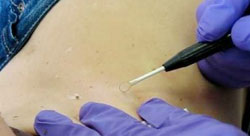Mole removal procedures are fast and uncomplicated if done by a knowledgeable and experienced dermatologist. After the mole is shaved or cut off, it is highly important for the patient to follow the steps given by their physician in order to heal properly. Even though it is almost impossible to prevent any scarring at all from appearing, allowing the incision to heal properly will bring you as close as you’ll be able to get. Not only will you avoid infections, too, but you’ll also end up with a less noticeable scar if you didn’t allow the healing process to finish. Don’t take chances when it comes to healing up – bacteria can seriously infect open wounds!.

Steps for Healing Properly
As small as your incision might be, it is extremely important to keep it clean in order for the healing process to take place. You should always follow instructions that your physician gives you. There are general guidelines that you can read up on beforehand, too. A few of the steps to follow after a mole removal procedure include:
- Making sure you find out if your physician closed the wound with dissolvable stitches or not. This will determine if you’re due for a follow-up visit to remove the stitches
- Always keeping the gauze on/ replacing gauze frequently
- Don’t stretch the area of the cut
- Using Steri-strips to accelerate the healing process
- Applying healing creams/ oils that are rich in vitamin E
- Massaging the area slightly once stiches are out
Benefits of Proper Aftercare
Plenty of people opt for mole removal procedures because they’re worried about how the mole messes up their appearance. There are a few types of moles that could pose a threat to your health and not all of them are always the nasty, growing melanomas that everyone suspects are cancerous. Still, the majority of people that have mole removals done are mainly due to cosmetic concerns. Despite the fact that the mole may not pose a threat, improper post-surgical care can result in major trouble. If the gauze isn’t removed frequently, the accumulation of fluids expelled by the wound can create conditions ripe for infections to breed. The main benefit of proper aftercare is the prevention of any dark scarring or infections.
When To Seek Attention
There are a few things that you must keep in mind after a mole removal procedure. It doesn’t matter what type of technique was performed either, or how small the mole was. Complications can always arise no matter what – it’s important that you’re aware of the process of keeping your wound clean. If you are not able to contact your dermatologist or physician, visit the hospital if you experience the following:
- If you notice that the incision starts to bleed heavily
- If you notice that there is discharge such as puss or fluids
- If you develop a high fever
- If pain doesn’t go away after taking medication
- If you notice any type of swelling
- If you notice increased redness or burning sensations
